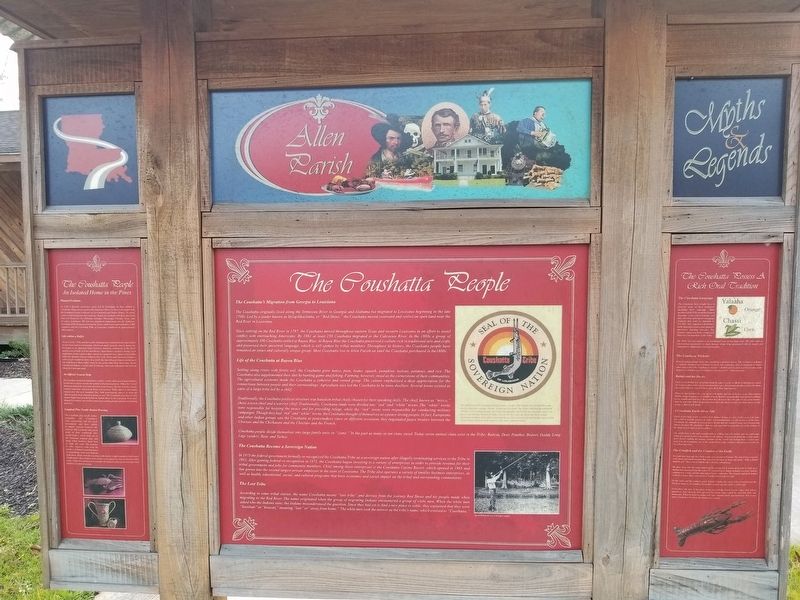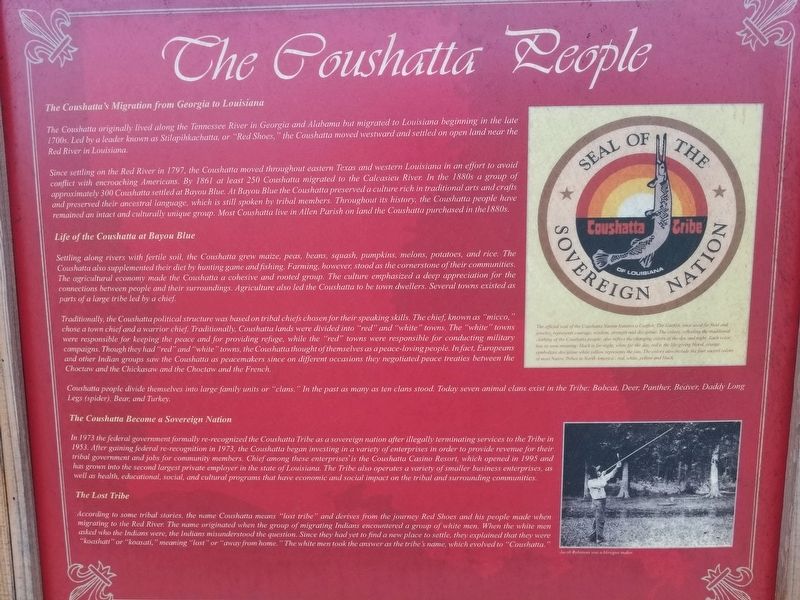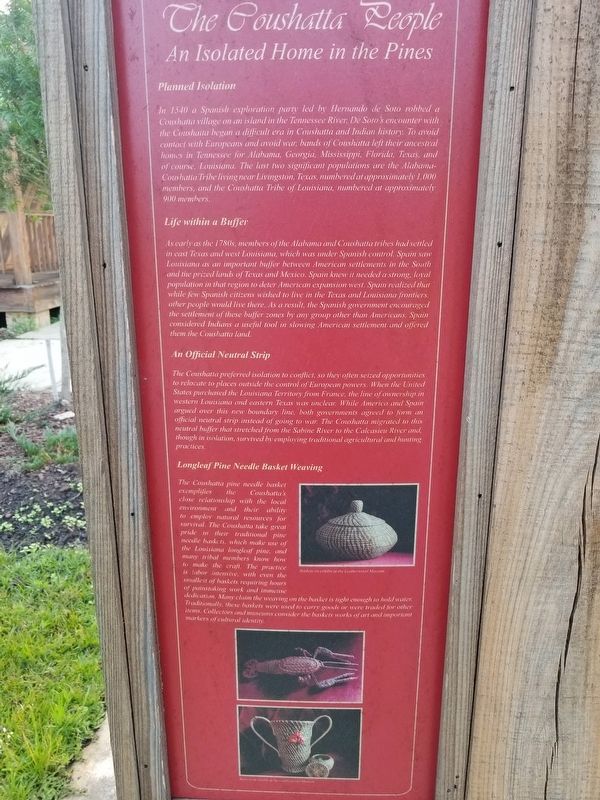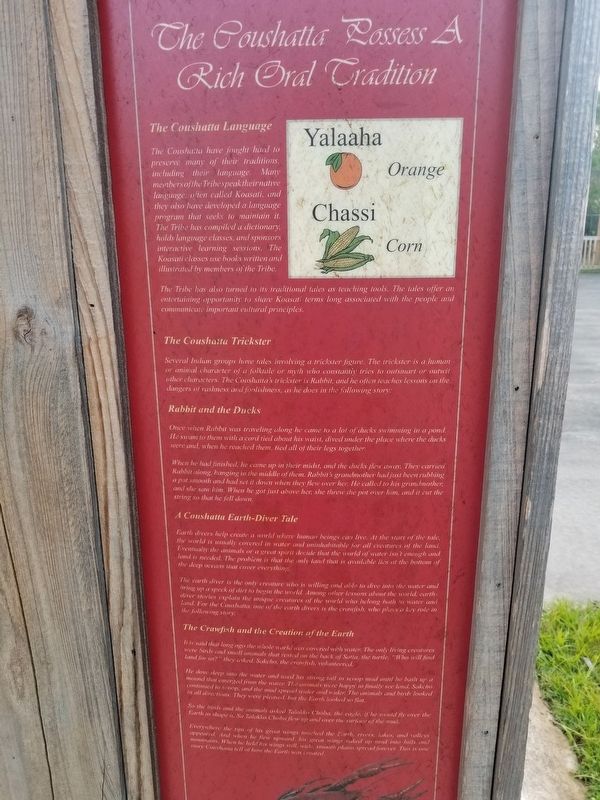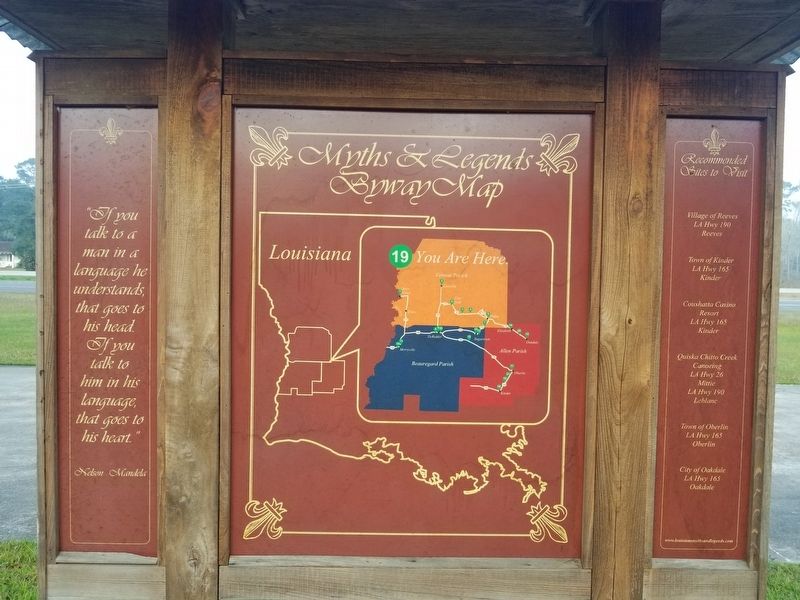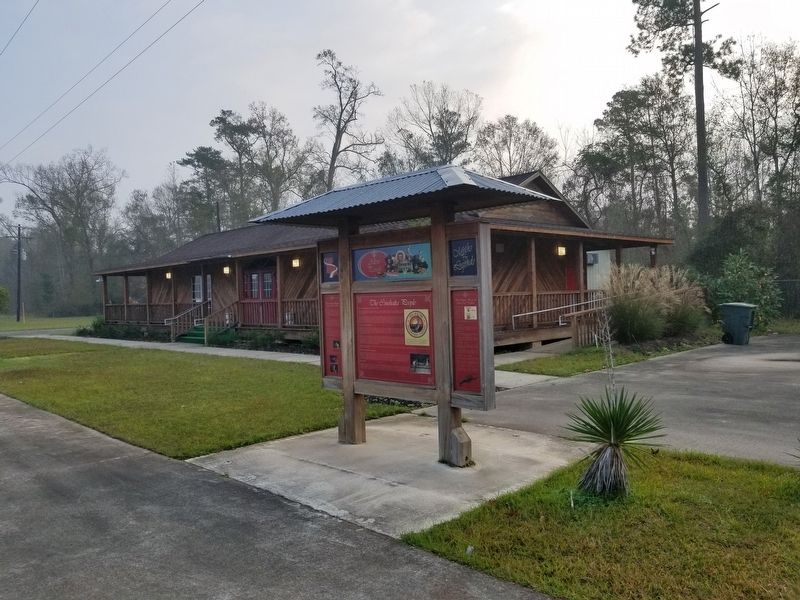Kinder in Allen Parish, Louisiana — The American South (West South Central)
The Coushatta People
Myths & Legends - Allen Parish
Main Panel
The Coushatta's Migration from Georgia to Louisiana
The Coushatta originally lived along the Tennessee River in Georgia and Alabama but migrated to Louisiana beginning in the late 1700s. Led by a leader known as Stilapihkachatta, or "Red Shoes,” the Coushatta moved westward and settled on open land near the Red River in Louisiana.
Since settling on the Red River in 1797, the Coushatta moved throughout eastern Texas and western Louisiana in an effort to avoid conflict with encroaching Americans. By 1861 at least 250 Coushatta migrated to the Calcasieu River. In the 1880s a group of approximately 300 Coushatta settled at Bayou Blue. At Bayou Blue the Coushatta preserved a culture rich in traditional arts and crafts and preserved their ancestral language, which is still spoken by tribal members. Throughout its history, the Coushatta people have remained an intact and culturally unique group. Most Coushatta live in Allen Parish on land the Coushatta purchased in the 1880s.
Life of the Coushatta at Bayou Blue
Settling along rivers with fertile soil, the Coushatta grew maize, peas, beans, squash, pumpkins, melons, potatoes, and rice. The Coushatta also supplemented their diet by hunting game and fishing. Farming, however, stood as the cornerstone of their communities. The agricultural economy made the Coushatta a cohesive and rooted group. The culture emphasized a deep appreciation for the connections between people and their surroundings. Agriculture also led the Coushatta to be town dwellers. Several towns existed as parts of a large tribe led by a chief.
Traditionally , the Coushatta political structure was based on tribal chiefs chosen for their speaking skills. The chief, known as “micco,” chose a town chief and a warrior chief. Traditionally, Coushatta lands were divided into “red” and “white” towns. The "white" towns were responsible for keeping the peace and for providing refuge, while the “red” towns were responsible for conducting military campaigns. Though they had “red” and “white" towns, the Coushatta thought of themselves as a peace-loving people. In fact, Europeans and other Indian groups saw the Coushatta as peacemakers since on different occasions they negotiated peace treaties between the Choctaw and the Chickasaw and the Choctaw and the French.
Coushatta people divided themselves into large family units or "clans." In the past as many as ten clans stood. Today seven animal clans exist in the tribe: Bobcat, Deer, Panther, Beaver, Daddy Long Legs (spider), Bear and Turkey.
The Coushatta Become a Sovereign Nation
In 1973 the federal government formally re-recognized the Coushatta Tribe as a sovereign nation after illegally terminating services to the Tribe in 1953. After gaining federal re-recognition in 1973, the Coushatta began investing in a variety of enterprises in order to provide revenue for their tribal government and jobs for community members. Chief among these enterprises is the Coushatta Casino Resort, which opened in 1995 and has grown into the second largest private employer in the state of Louisiana. The Tribe also operates a variety of smaller business enterprises, as well as health, educational, social, and cultural programs that have economic and social impact on the tribal and surrounding communities.
The Lost Tribe
According to some tribal stories, the name Coushatta means "lost tribe" and derives from the journey Red Shoes and his people made when migrating to the Red River. The name originated when the group of migrating Indians encountered a group of white men. When the white men asked who the Indians were, the Indians misunderstood the question. Since they had yet to find a new place to settle, they explained that they were “koashatt” or “koasati,” meaning “lost" or "away from home.” The white men took the answer as the tribe's name, which evolved to “Coushatta.
Left Panel
The Coushatta People
An Isolated Home in the Pines
Planned Isolation
In 1540 a Spanish exploration party led by Hernando de Soto robbed a Coushatta village on an island in the Tennessee River: De Soto s encounter with S the Coushatta began a difficult era in Coushatta and Indian history. To avoid contact with Europeans and avoid war; bands of Coushatta left their ancestral homes in Tennessee for Alabama, Georgia, Mississippi, Florida, Texas, and of course, Louisiana. The last two significant populations are the Alabama- Coushatta Tribe living near Livingston, Texas, numbered at approximately 1,000 members, and the Coushatta Tribe of Louisiana, numbered at approximately 900 members.
Life within a Buffer
As early as the 1780s, members of the Alabama and Coushatta tribes had settled in east Texas and west Louisiana, which was under Spanish control. Spain saw Louisiana ds an important buffer between American settlements in the South and the prized lands of Texas and Mexico. Spain knew it needed a strong, loyal population in that region to deter American expansion west. Spain realized that while few Spanish citizens wished to live in the Texas and Louisiana frontiers, other people would live there. As a result, the Spanish government encouraged the settlement of these buffer zones by any group other than Americans. Spain considered Indians a useful tool in slowing American settlement and offered them the Coushatta land.
An Official Neutral Strip
The Coushatta preferred isolation to conflict, so they often seized opportunities to relocate to places outside the control of European powers. When the United States purchased the Louisiana Territory from France, the line of ownership in western Louisiana and eastern Texas was unclear. While America and Spain argued over this new boundary line, both governments agreed to form an official neutral strip instead of going to war: The Coushatta migrated to this neutral buffer that stretched from the Sabine River to the Calcasieu River and, though in isolation, survived by employing traditional agricultural and hunting practices.
Longleaf Pine Needle Basket Weaving
The Coushatta pine needle basket exemplifies the Coushatta's close relationship with the local environment and their ability: to employ natural resources for survival. The Coushatta take great pride in their traditional pine needle baskets, which make use of the Louisiana longleaf pine, and many tribal members know how to make the craft. The practice is labor intensive, with even the smallest of baskets requiring hours of painstaking work and immense dedication. Many claim the weaving on the basket is tight enough to hold water: Traditionally, these baskets were used to carry goods or were traded for other items. Collectors and museums consider the baskets works of art and important markers of cultural identity.
Right
Panel
The Coushatta Possess A Rich And Oral Tradition
The Coushatta Language
The Coushatta have fought hard to preserve many of their traditions, including their language. Many members of the Tribe speak their native language, often called Koasati, and they also have developed a language program that seeks to maintain it. The Tribe has compiled a dictionary, holds language classes, and sponsors interactive learning sessions. The Koasati classes use books written and illustrated by members of the Tribe.
The Tribe has also turned to its traditional tales as teaching tools. The tales offer an entertaining opportunity to share Koasati terms long associated with the people and communicate important cultural principles.
The Coushaita Trickster
Several Indian groups have tales involving a trickster figure. The trickster is a human Or animal character of a folktale or myth who constantly tries to outsmart or outwit other characters. The Coushatta's trickster is Rabbit, and he often teaches lessons on the dangers of rashness and foolishness, as he does in the following story:
Rabbit and the Ducks
Once when Rabbit was traveling along he came to a lot of ducks swimming in a pond. He swam to them with a/cord tied about his waist, dived under the place where the ducks were and, when he reached them, tied all of their legs together When he had finished, he came up in their midst, and the ducks flew away. They carried Rabbit along, hanging in the middle of them. Rabbit's grandmother had just been rubbing a pot smooth and had set it down when they flew over her. He called to his grandmother, and she saw him. When he got just above her, she threw the pot over him, and it cut the string so that he fell down.
A Coushatta Earth-Diver Tale
Earth divers help create a world where human beings can live. At the start of the tale, the world is usually covered in water and uninhabitable for all creatures of the land. Eventually the animals or a great spirit decide that the world of water isn't enough and land is needed. The problem is that the only land that is available lies at the bottom of the deep oceans that cover everything, The earth diver is the only creature who is willing and able to dive into the water and bring up a speck of dirt to begin the world. Among other lessons about the world, earth- diver stories explain the unique creatures of the world who belong both to water and land. For the Coushatta, one of the earth divers is the crawfish, who plays a key role in the following story.
The Crawfish and the Creation of the Earth
It is said that long ago the whole world was covered with water. The only living creatures were birds and small animals that rested on the back of Satta, the turtle. "Who will find land for us?” they asked. Sakcho, the crawfish, volunteered. He dove deep into the water and used his strong tail to scoop mud until he built up a mound that emerged from the water. The animals were happy to finally see land. Sakcho continued to scoop, and the mud spread wider and wider: The animals and birds looked in all directions. They were pleased, but the Earth looked so flat. So the birds and the animals asked Talokko Choba, the eagle, if he would fly over the Earth to shape it. So Talokko Choba flew up and over the surface of the mud. Everywhere the tips of his great wings touched the Earth, rivers, lakes, and valleys appeared. And when he flew upward, his great wings raked up mud into hills and mountains. When he held his wings still, wide, smooth plains spread forever. This is one story Coushatta tell of how the Earth was created.
Erected by State of Louisiana Myths & Legends Trails and Byways. (Marker Number 19.)
Topics and series. This historical marker is listed in this topic list: Native Americans. In addition, it is included in the Louisiana Myths & Legends Byway series list.
Location. 30° 31.305′ N, 92° 49.588′ W. Marker is in Kinder, Louisiana, in Allen Parish. Marker is on U.S. 165, one mile north of Clyde Chachere Road, on the right when traveling north. Touch for map. Marker is in this post office area: Kinder LA 70648, United States of America. Touch for directions.
Other nearby markers. At least 8 other markers are within 8 miles of this marker, measured as the crow flies. 1st. Lt. Douglas Bernard Fournet (approx. 1.4 miles away); St. Paul Baptist Church (approx. 1.9 miles away); 1st. Lt. Douglas B. Fournet (approx. 2.7 miles away); Kinder War Monument (approx. 2.7 miles away); Kinder: The Crossroads to Everywhere (approx. 2.8 miles away); Great Louisiana Maneuvers' Blue Army Headquarters (approx. 2.8 miles away); Kinder, Louisiana (approx. 2.9 miles away); Oberlin: A Blending of Cultures (approx. 7.7 miles away). Touch for a list and map of all markers in Kinder.
More about this marker. Located at the Allen Parish Welcome Center, Kinder, LA.
Also see . . . Official State of Louisiana Link to Myths and Legends Byways. (Submitted on December 31, 2021, by Cajun Scrambler of Assumption, Louisiana.)
Credits. This page was last revised on December 31, 2021. It was originally submitted on December 31, 2021, by Cajun Scrambler of Assumption, Louisiana. This page has been viewed 994 times since then and 99 times this year. Photos: 1, 2, 3, 4, 5, 6. submitted on December 31, 2021, by Cajun Scrambler of Assumption, Louisiana.
